The Primary Structure of DNA
The primary structure of DNA consists of a string of nucleotides joined together by phosphodiester linkages.
NUCLEOTIDES DNA is typically a very long molecule and is therefore termed a macromolecule. For example, within each human chromosome is a single DNA molecule that, if stretched out straight, would be several centimeters in length, thousands of times longer than the cell itself. In spite of its large size, DNA has quite a simple structure: it is a polymer—
The sugars of nucleic acids—
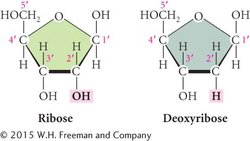
The second component of a nucleotide is its nitrogenous base, which may be either of two types: a purine or a pyrimidine (Figure 8.8). Each purine consists of a six-
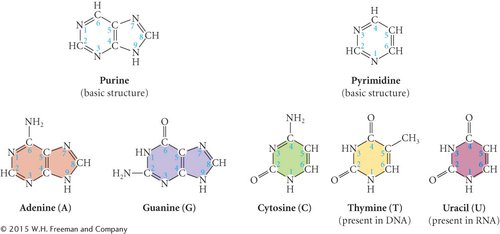
The third component of a nucleotide is the phosphate group, which consists of a phosphorus atom bonded to four oxygen atoms (Figure 8.9). Phosphate groups are found in every nucleotide and frequently carry a negative charge, which makes DNA acidic. The phosphate group is always bonded to the 5′-carbon atom of the sugar (see Figure 8.7) in a nucleotide.
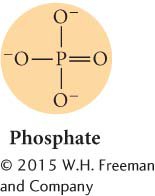
The DNA nucleotides are properly known as deoxyribonucleotides, or deoxyribonucleoside 5′-monophosphates. Because there are four types of bases, there are four different kinds of DNA nucleotides (Figure 8.10). The equivalent RNA nucleotides are termed ribonucleotides, or ribonucleoside 5′-monophosphates. RNA molecules sometimes contain additional rare bases, which are modified forms of the four common bases. These modified bases will be discussed in more detail when we examine the function of RNA molecules in Chapter 10. The names for DNA bases, nucleotides, and nucleosides are shown in Table 8.2.  TRY PROBLEM 21
TRY PROBLEM 21
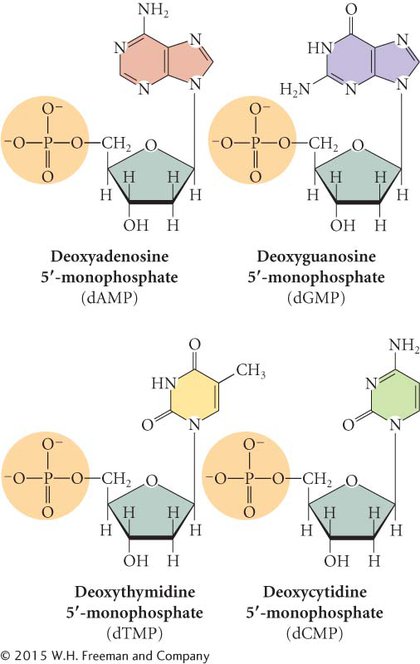
| Adenine | Guanine | Thymine | Cytosine | |
|---|---|---|---|---|
| Base symbol | A | G | T | C |
| Nucleotide | Deoxyadenosine 5′ monophosphate | Deoxyguanosine 5′ monophosphate | Deoxythymidine 5′ monophosphate | Deoxycytidine 5′ monophosphate |
| Nucleotide symbol | dAMP | dGMP | dTMP | dCMP |
| Nucleoside | Deoxyadenosine | Deoxyguanosine | Deoxythymidine | Deoxycytidine |
| Nucleoside symbol | dA | dG | dT | dC |
CONCEPTS
The primary structure of DNA consists of a string of nucleotides. Each nucleotide consists of a five-
 CONCEPT CHECK 4
CONCEPT CHECK 4
How do the sugars of RNA and DNA differ?
RNA has a six-
carbon sugar; DNA has a five- carbon sugar. The sugar of RNA has a hydroxyl group that is not found in the sugar of DNA.
RNA contains uracil; DNA contains thymine.
DNA’s sugar has a phosphorus atom; RNA’s sugar does not.
b
POLYNUCLEOTIDE STRANDS DNA is made up of many nucleotides, which are connected by covalent bonds that link the 5′-phosphate group of one nucleotide to the 3′-hydroxyl group of the next nucleotide (Figure 8.11; it should be noted that the structures shown in this illustration are flattened into two dimensions, while the molecule itself is three-
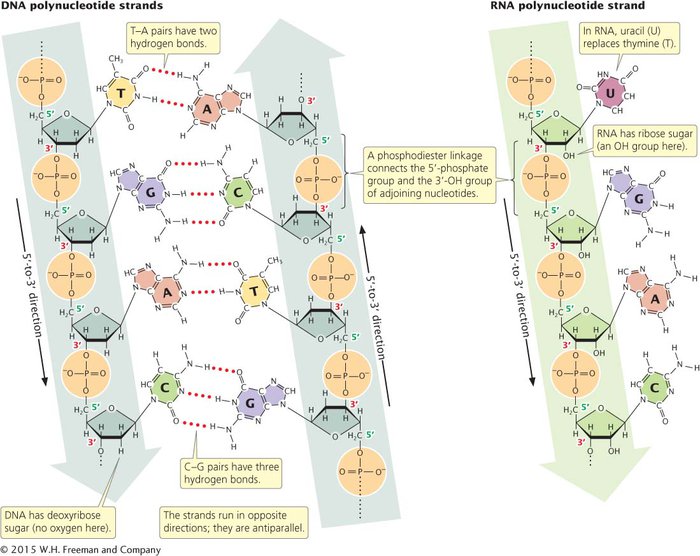
An important characteristic of the polynucleotide strand is its direction, or polarity. At one end of the strand, a free phosphate group (meaning that it’s unattached on one side) is attached to the 5′-carbon atom of the sugar in the nucleotide. This end of the strand is therefore referred to as the 5′ end. The other end of the strand, referred to as the 3′ end, has a free OH group attached to the 3′-carbon atom of the sugar. RNA nucleotides are also connected by phosphodiester linkages to form similar polynucleotide strands (see Figure 8.11).
CONCEPTS
The nucleotides of DNA are joined to form polynucleotide strands by phosphodiester linkages that connect the 3′-carbon atom of one nucleotide to the 5′-phosphate group of the next. Each polynucleotide strand has polarity, with a 5′ end and a 3′ end.